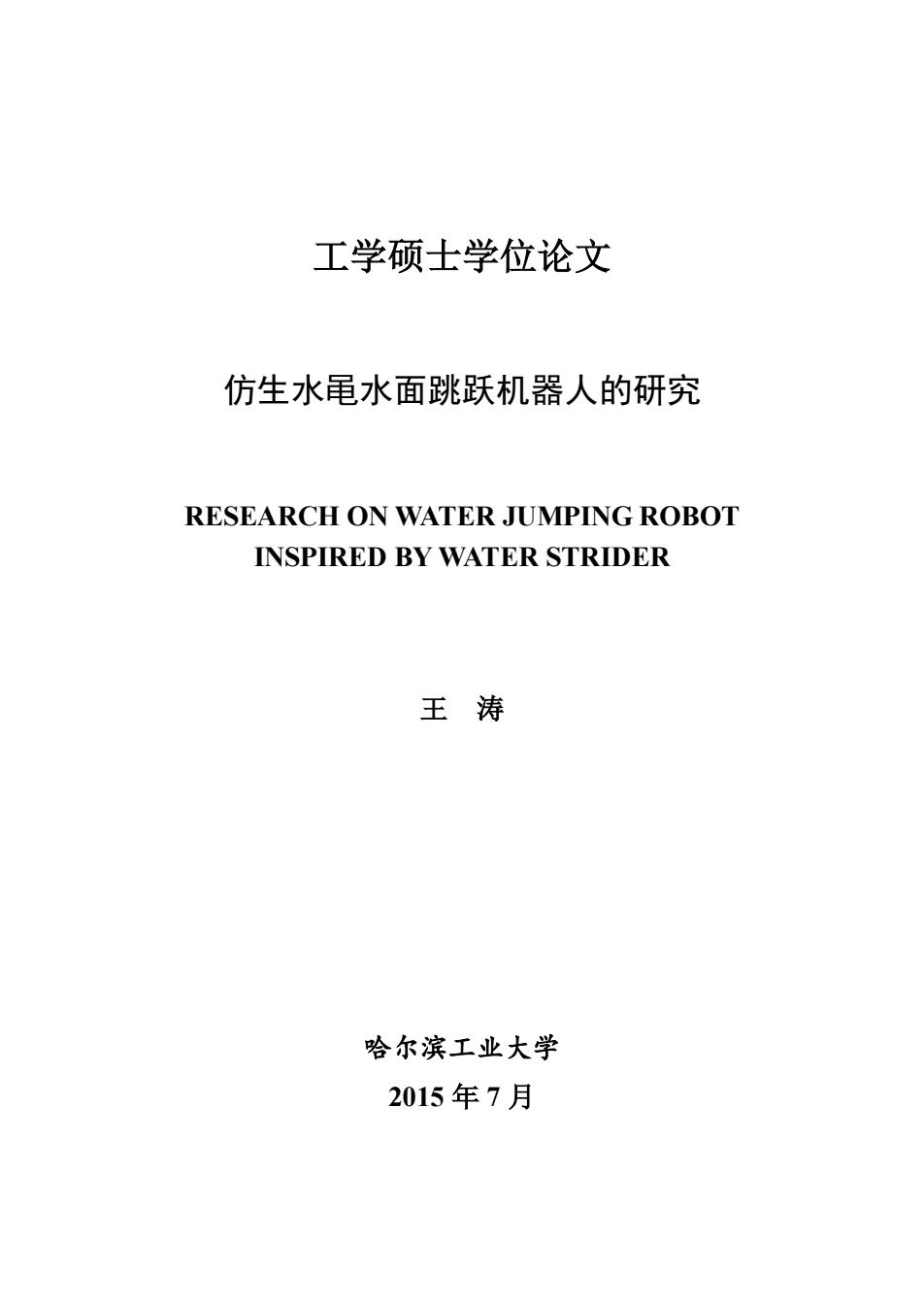
工学硕士学位论文 仿生水黾水面跳跃机器人的研究 RESEARCH ON WATER JUMPING ROBOT INSPIRED BY WATER STRIDER 王涛 哈尔滨工业大学 2015年7月
工学硕士学位论文 仿生水黾水面跳跃机器人的研究 RESEARCH ON WATER JUMPING ROBOT INSPIRED BY WATER STRIDER 王 涛 哈尔滨工业大学 2015 年 7 月
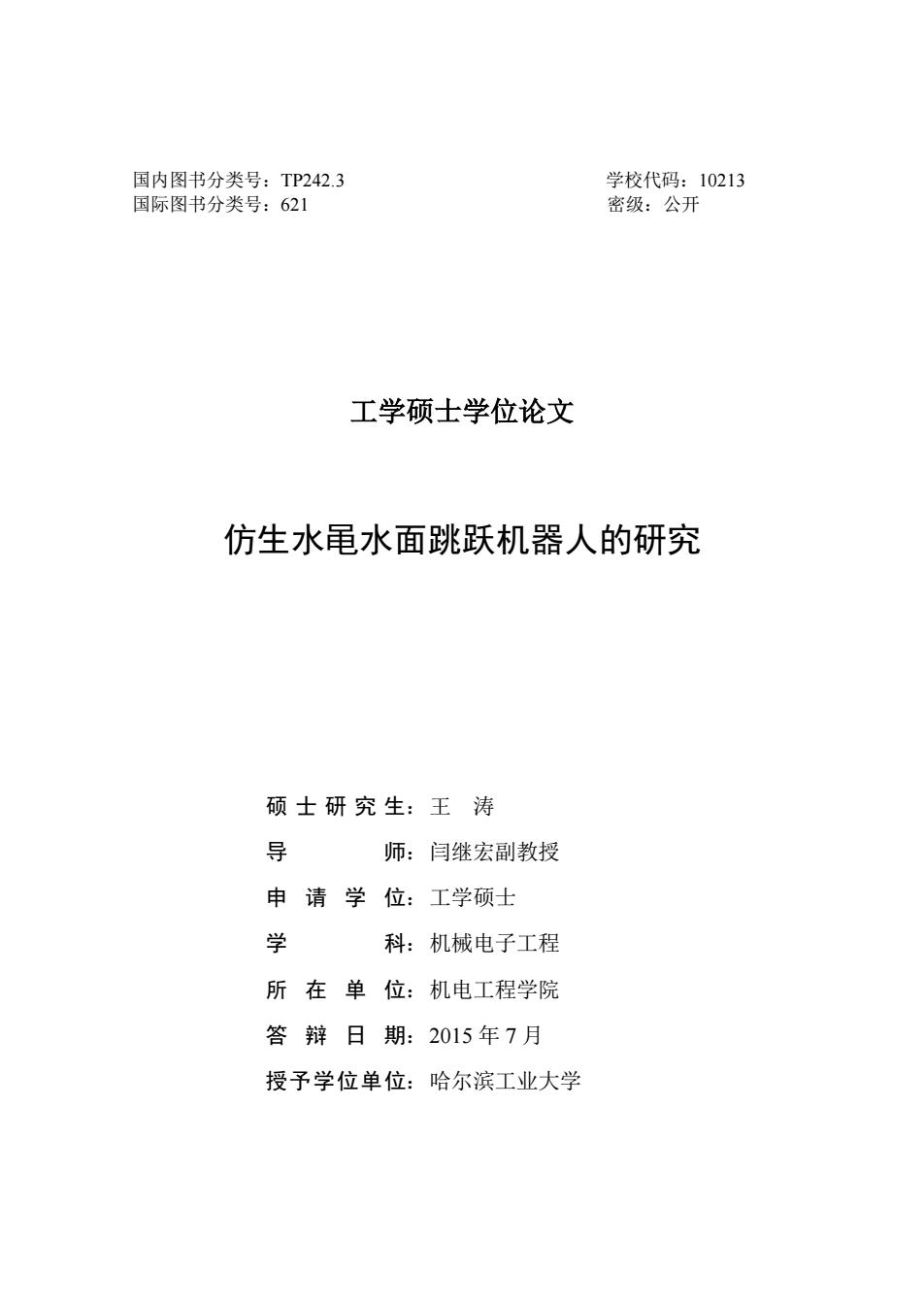
国内图书分类号:TP242.3 学校代码:10213 国际图书分类号:621 密级:公开 工学硕士学位论文 仿生水龟水面跳跃机器人的研究 硕士研究生:王涛 导 师:闫继宏副教授 申请学位:工学硕士 学 科:机械电子工程 所在单位:机电工程学院 答辩日期:2015年7月 授予学位单位:哈尔滨工业大学
国内图书分类号:TP242.3 学校代码:10213 国际图书分类号:621 密级:公开 工学硕士学位论文 仿生水黾水面跳跃机器人的研究 硕 士研究生:王 涛 导 师:闫继宏副教授 申请学位:工学硕士 学 科:机械电子工程 所 在 单 位:机电工程学院 答 辩 日 期:2015 年 7 月 授予学位单位:哈尔滨工业大学
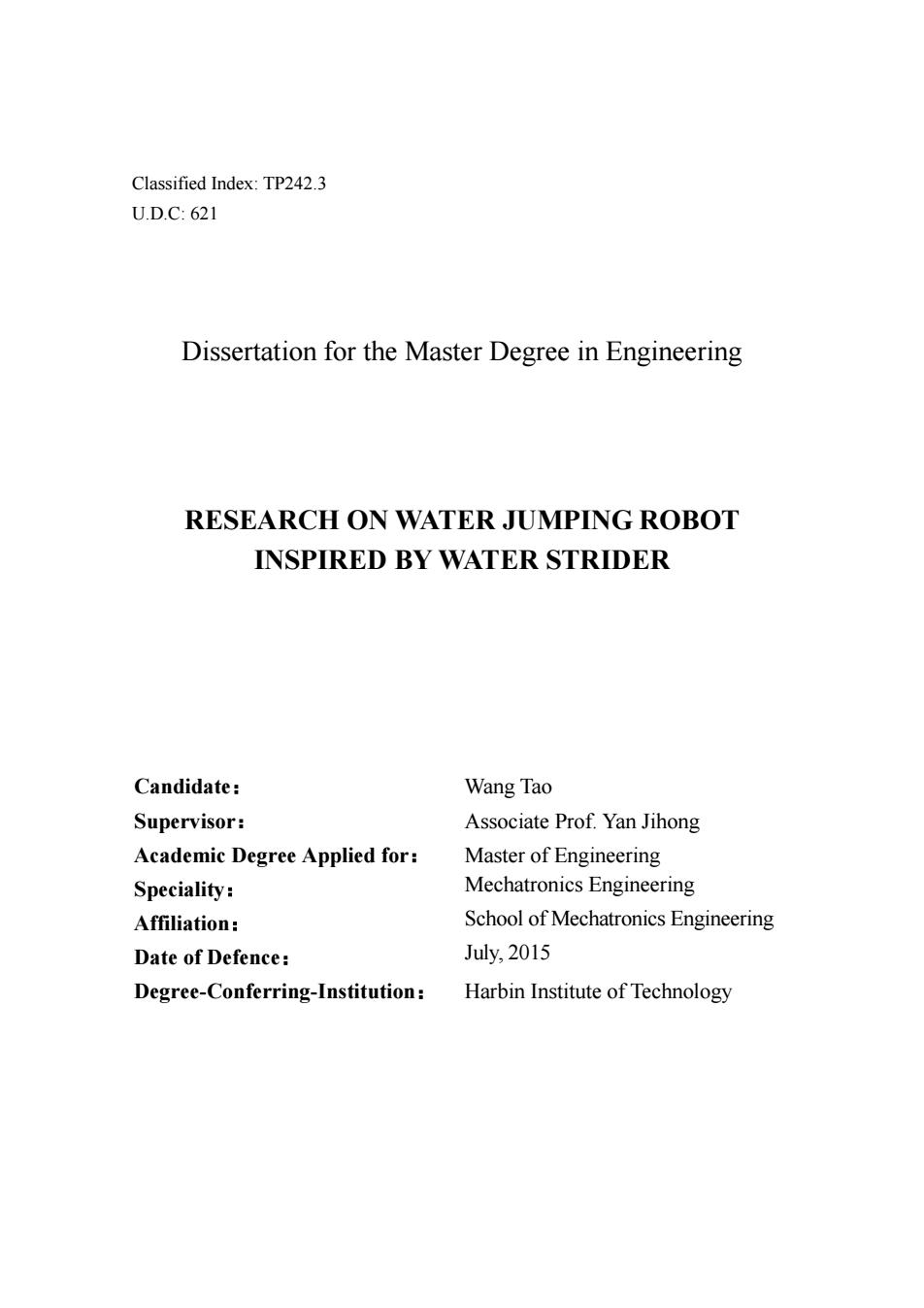
Classified Index:TP242.3 UD.C:621 Dissertation for the Master Degree in Engineering RESEARCH ON WATER JUMPING ROBOT INSPIRED BY WATER STRIDER Candidate: Wang Tao Supervisor: Associate Prof.Yan Jihong Academic Degree Applied for: Master of Engineering Speciality Mechatronics Engineering Affiliation: School of Mechatronics Engineering Date of Defence: July,2015 Degree-Conferring-Institution: Harbin Institute of Technology
Classified Index: TP242.3 U.D.C: 621 Dissertation for the Master Degree in Engineering RESEARCH ON WATER JUMPING ROBOT INSPIRED BY WATER STRIDER Candidate: Wang Tao Supervisor: Associate Prof. Yan Jihong Academic Degree Applied for: Master of Engineering Speciality: Mechatronics Engineering Affiliation: School of Mechatronics Engineering Date of Defence: July, 2015 Degree-Conferring-Institution: Harbin Institute of Technology
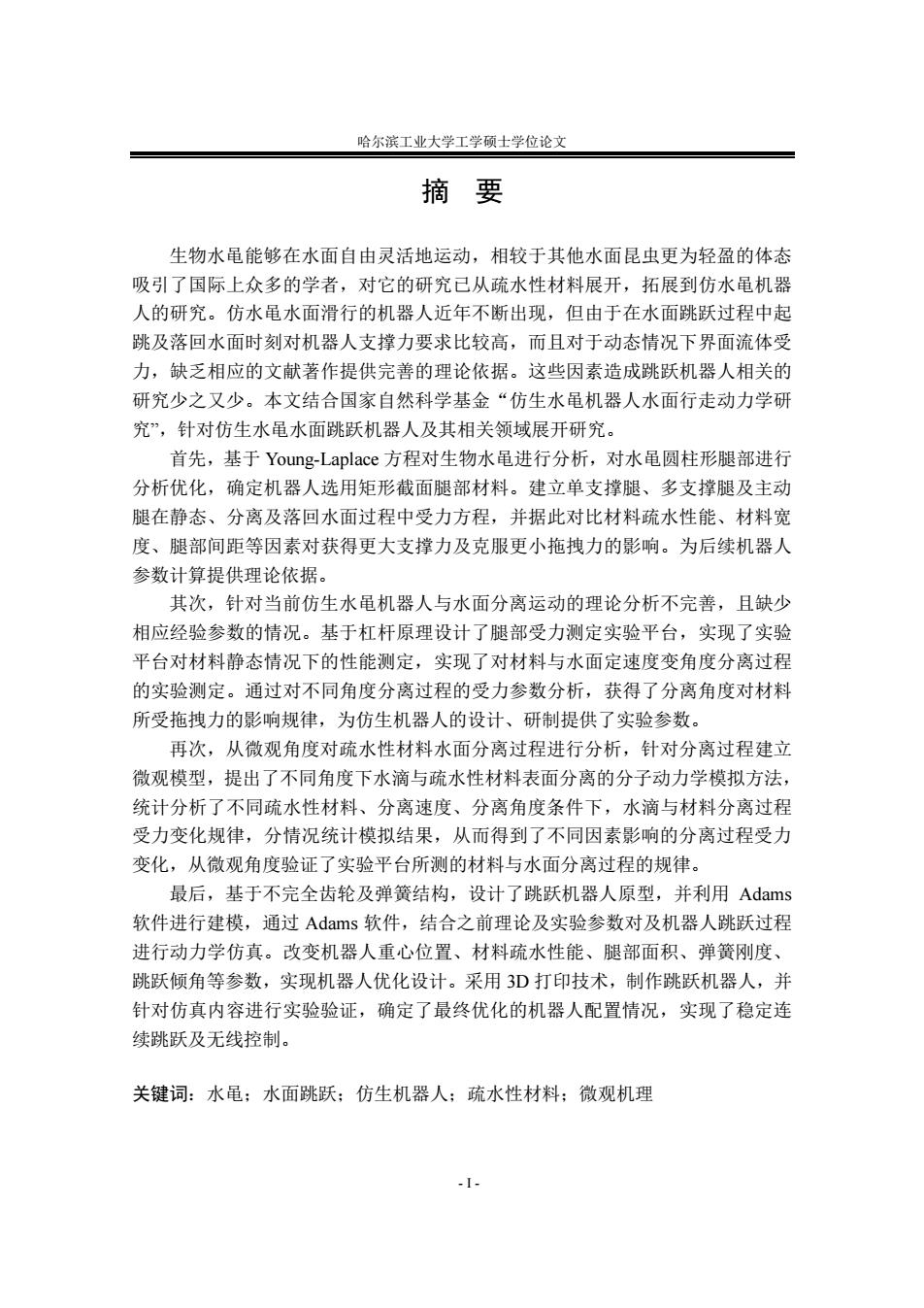
哈尔滨工业大学工学硕士学位论文 摘要 生物水黾能够在水面自由灵活地运动,相较于其他水面昆虫更为轻盈的体态 吸引了国际上众多的学者,对它的研究已从疏水性材料展开,拓展到仿水黾机器 人的研究。仿水黾水面滑行的机器人近年不断出现,但由于在水面跳跃过程中起 跳及落回水面时刻对机器人支撑力要求比较高,而且对于动态情况下界面流体受 力,缺乏相应的文献著作提供完善的理论依据。这些因素造成跳跃机器人相关的 研究少之又少。本文结合国家自然科学基金“仿生水黾机器人水面行走动力学研 究”,针对仿生水黾水面跳跃机器人及其相关领域展开研究。 首先,基于Young-Laplace方程对生物水黾进行分析,对水黾圆柱形腿部进行 分析优化,确定机器人选用矩形截面腿部材料。建立单支撑腿、多支撑腿及主动 腿在静态、分离及落回水面过程中受力方程,并据此对比材料疏水性能、材料宽 度、腿部间距等因素对获得更大支撑力及克服更小拖拽力的影响。为后续机器人 参数计算提供理论依据。 其次,针对当前仿生水黾机器人与水面分离运动的理论分析不完善,且缺少 相应经验参数的情况。基于杠杆原理设计了腿部受力测定实验平台,实现了实验 平台对材料静态情况下的性能测定,实现了对材料与水面定速度变角度分离过程 的实验测定。通过对不同角度分离过程的受力参数分析,获得了分离角度对材料 所受拖拽力的影响规律,为仿生机器人的设计、研制提供了实验参数。 再次,从微观角度对疏水性材料水面分离过程进行分析,针对分离过程建立 微观模型,提出了不同角度下水滴与疏水性材料表面分离的分子动力学模拟方法, 统计分析了不同疏水性材料、分离速度、分离角度条件下,水滴与材料分离过程 受力变化规律,分情况统计模拟结果,从而得到了不同因素影响的分离过程受力 变化,从微观角度验证了实验平台所测的材料与水面分离过程的规律。 最后,基于不完全齿轮及弹簧结构,设计了跳跃机器人原型,并利用Adams 软件进行建模,通过Adams软件,结合之前理论及实验参数对及机器人跳跃过程 进行动力学仿真。改变机器人重心位置、材料疏水性能、腿部面积、弹簧刚度、 跳跃倾角等参数,实现机器人优化设计。采用3D打印技术,制作跳跃机器人,并 针对仿真内容进行实验验证,确定了最终优化的机器人配置情况,实现了稳定连 续跳跃及无线控制。 关键词:水黾;水面跳跃:仿生机器人;疏水性材料:微观机理
哈尔滨工业大学工学硕士学位论文 - I - 摘 要 生物水黾能够在水面自由灵活地运动,相较于其他水面昆虫更为轻盈的体态 吸引了国际上众多的学者,对它的研究已从疏水性材料展开,拓展到仿水黾机器 人的研究。仿水黾水面滑行的机器人近年不断出现,但由于在水面跳跃过程中起 跳及落回水面时刻对机器人支撑力要求比较高,而且对于动态情况下界面流体受 力,缺乏相应的文献著作提供完善的理论依据。这些因素造成跳跃机器人相关的 研究少之又少。本文结合国家自然科学基金“仿生水黾机器人水面行走动力学研 究”,针对仿生水黾水面跳跃机器人及其相关领域展开研究。 首先,基于 Young-Laplace 方程对生物水黾进行分析,对水黾圆柱形腿部进行 分析优化,确定机器人选用矩形截面腿部材料。建立单支撑腿、多支撑腿及主动 腿在静态、分离及落回水面过程中受力方程,并据此对比材料疏水性能、材料宽 度、腿部间距等因素对获得更大支撑力及克服更小拖拽力的影响。为后续机器人 参数计算提供理论依据。 其次,针对当前仿生水黾机器人与水面分离运动的理论分析不完善,且缺少 相应经验参数的情况。基于杠杆原理设计了腿部受力测定实验平台,实现了实验 平台对材料静态情况下的性能测定,实现了对材料与水面定速度变角度分离过程 的实验测定。通过对不同角度分离过程的受力参数分析,获得了分离角度对材料 所受拖拽力的影响规律,为仿生机器人的设计、研制提供了实验参数。 再次,从微观角度对疏水性材料水面分离过程进行分析,针对分离过程建立 微观模型,提出了不同角度下水滴与疏水性材料表面分离的分子动力学模拟方法, 统计分析了不同疏水性材料、分离速度、分离角度条件下,水滴与材料分离过程 受力变化规律,分情况统计模拟结果,从而得到了不同因素影响的分离过程受力 变化,从微观角度验证了实验平台所测的材料与水面分离过程的规律。 最后,基于不完全齿轮及弹簧结构,设计了跳跃机器人原型,并利用 Adams 软件进行建模,通过 Adams 软件,结合之前理论及实验参数对及机器人跳跃过程 进行动力学仿真。改变机器人重心位置、材料疏水性能、腿部面积、弹簧刚度、 跳跃倾角等参数,实现机器人优化设计。采用 3D 打印技术,制作跳跃机器人,并 针对仿真内容进行实验验证,确定了最终优化的机器人配置情况,实现了稳定连 续跳跃及无线控制。 关键词:水黾;水面跳跃;仿生机器人;疏水性材料;微观机理
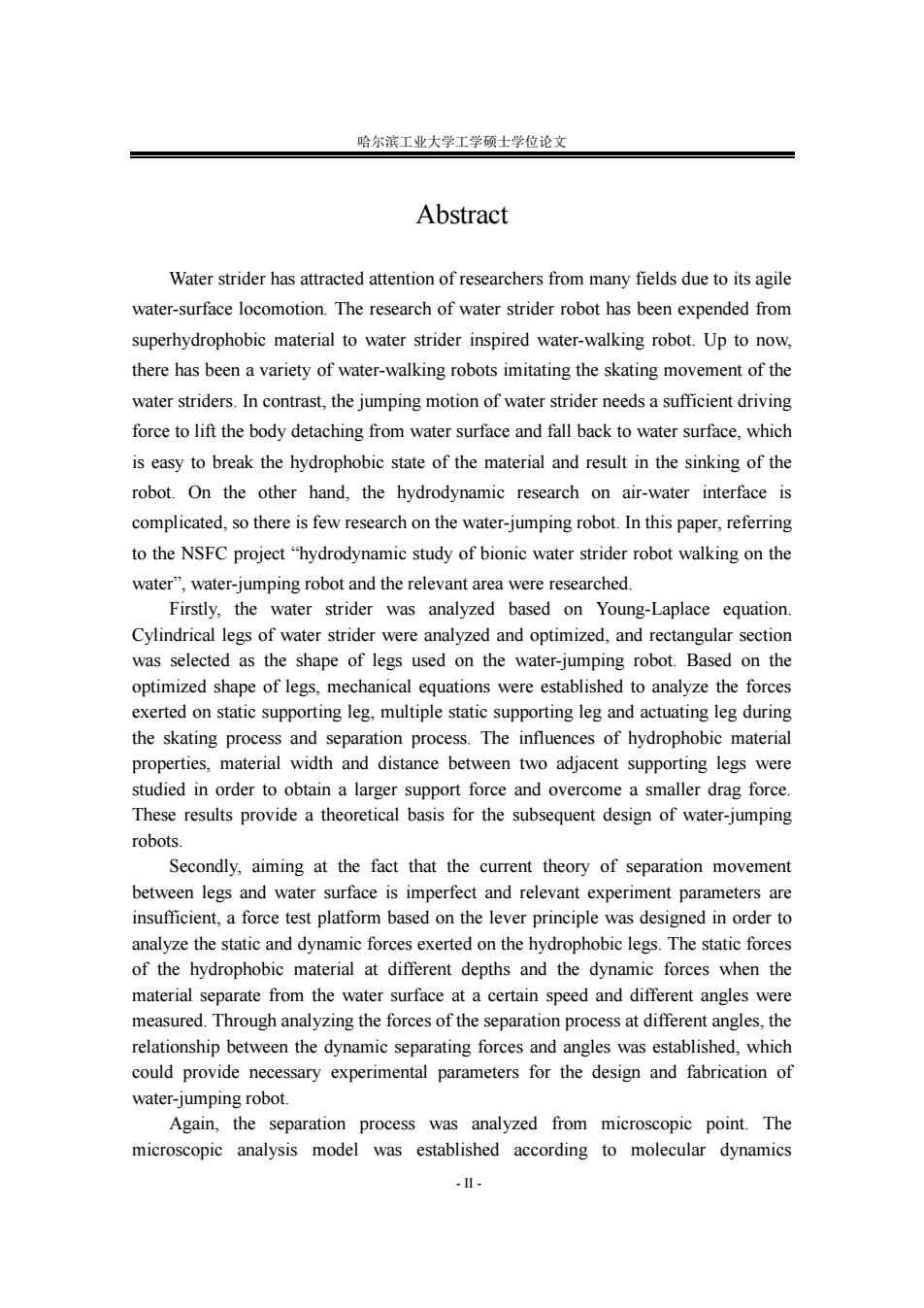
哈尔滨工业大学工学硕士学位论文 Abstract Water strider has attracted attention of researchers from many fields due to its agile water-surface locomotion.The research of water strider robot has been expended from superhydrophobic material to water strider inspired water-walking robot.Up to now, there has been a variety of water-walking robots imitating the skating movement of the water striders.In contrast,the jumping motion of water strider needs a sufficient driving force to lift the body detaching from water surface and fall back to water surface,which is easy to break the hydrophobic state of the material and result in the sinking of the robot.On the other hand,the hydrodynamic research on air-water interface is complicated,so there is few research on the water-jumping robot.In this paper,referring to the NSFC project "hydrodynamic study of bionic water strider robot walking on the water",water-jumping robot and the relevant area were researched. Firstly,the water strider was analyzed based on Young-Laplace equation. Cylindrical legs of water strider were analyzed and optimized,and rectangular section was selected as the shape of legs used on the water-jumping robot.Based on the optimized shape of legs,mechanical equations were established to analyze the forces exerted on static supporting leg,multiple static supporting leg and actuating leg during the skating process and separation process.The influences of hydrophobic material properties,material width and distance between two adjacent supporting legs were studied in order to obtain a larger support force and overcome a smaller drag force. These results provide a theoretical basis for the subsequent design of water-jumping robots. Secondly,aiming at the fact that the current theory of separation movement between legs and water surface is imperfect and relevant experiment parameters are insufficient,a force test platform based on the lever principle was designed in order to analyze the static and dynamic forces exerted on the hydrophobic legs.The static forces of the hydrophobic material at different depths and the dynamic forces when the material separate from the water surface at a certain speed and different angles were measured.Through analyzing the forces of the separation process at different angles,the relationship between the dynamic separating forces and angles was established,which could provide necessary experimental parameters for the design and fabrication of water-jumping robot. Again,the separation process was analyzed from microscopic point.The microscopic analysis model was established according to molecular dynamics -Ⅱ-
哈尔滨工业大学工学硕士学位论文 - II - Abstract Water strider has attracted attention of researchers from many fields due to its agile water-surface locomotion. The research of water strider robot has been expended from superhydrophobic material to water strider inspired water-walking robot. Up to now, there has been a variety of water-walking robots imitating the skating movement of the water striders. In contrast, the jumping motion of water strider needs a sufficient driving force to lift the body detaching from water surface and fall back to water surface, which is easy to break the hydrophobic state of the material and result in the sinking of the robot. On the other hand, the hydrodynamic research on air-water interface is complicated, so there is few research on the water-jumping robot. In this paper, referring to the NSFC project “hydrodynamic study of bionic water strider robot walking on the water”, water-jumping robot and the relevant area were researched. Firstly, the water strider was analyzed based on Young-Laplace equation. Cylindrical legs of water strider were analyzed and optimized, and rectangular section was selected as the shape of legs used on the water-jumping robot. Based on the optimized shape of legs, mechanical equations were established to analyze the forces exerted on static supporting leg, multiple static supporting leg and actuating leg during the skating process and separation process. The influences of hydrophobic material properties, material width and distance between two adjacent supporting legs were studied in order to obtain a larger support force and overcome a smaller drag force. These results provide a theoretical basis for the subsequent design of water-jumping robots. Secondly, aiming at the fact that the current theory of separation movement between legs and water surface is imperfect and relevant experiment parameters are insufficient, a force test platform based on the lever principle was designed in order to analyze the static and dynamic forces exerted on the hydrophobic legs. The static forces of the hydrophobic material at different depths and the dynamic forces when the material separate from the water surface at a certain speed and different angles were measured. Through analyzing the forces of the separation process at different angles, the relationship between the dynamic separating forces and angles was established, which could provide necessary experimental parameters for the design and fabrication of water-jumping robot. Again, the separation process was analyzed from microscopic point. The microscopic analysis model was established according to molecular dynamics
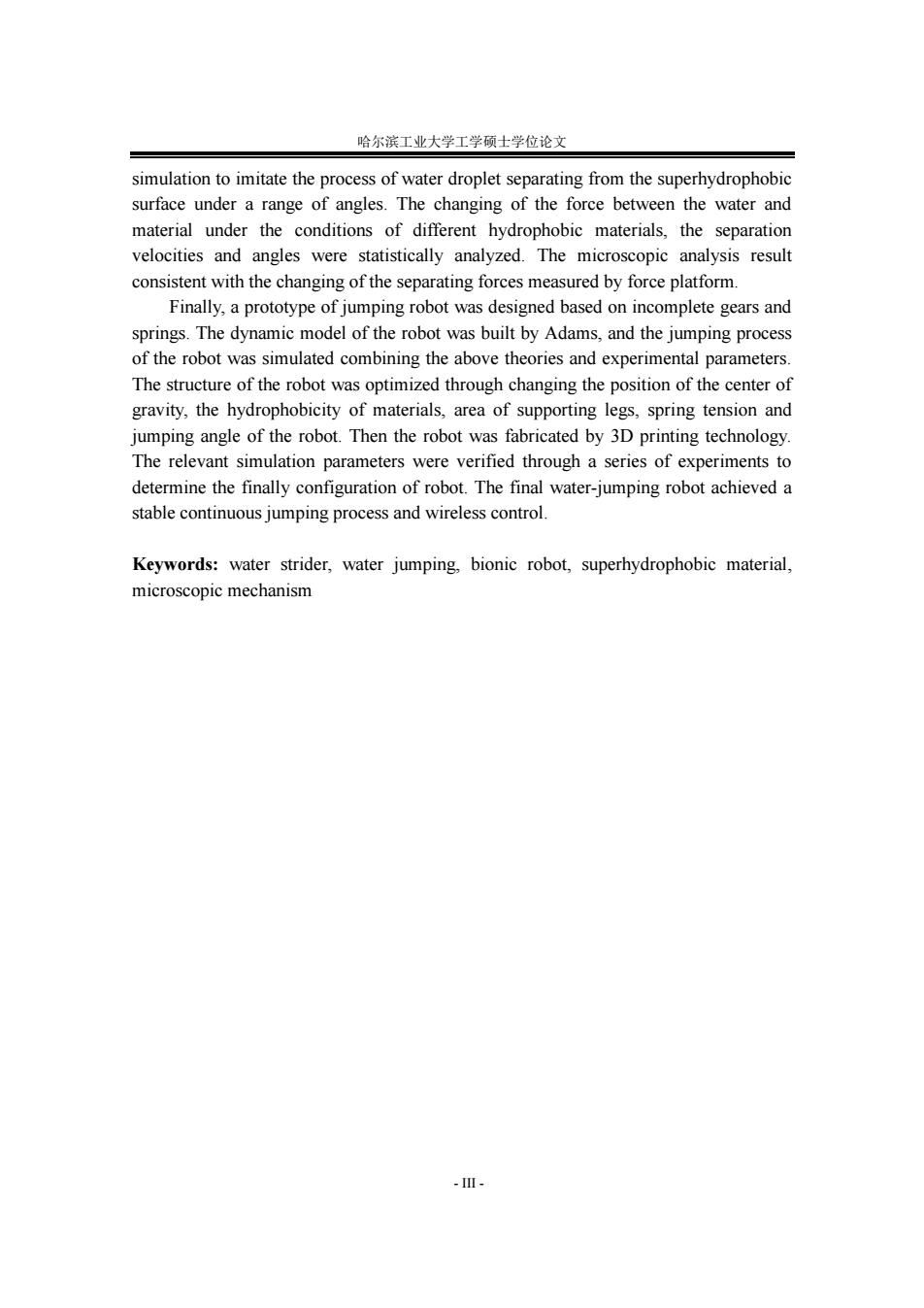
哈尔滨工业大学工学硕士学位论文 simulation to imitate the process of water droplet separating from the superhydrophobic surface under a range of angles.The changing of the force between the water and material under the conditions of different hydrophobic materials,the separation velocities and angles were statistically analyzed.The microscopic analysis result consistent with the changing of the separating forces measured by force platform Finally,a prototype of jumping robot was designed based on incomplete gears and springs.The dynamic model of the robot was built by Adams,and the jumping process of the robot was simulated combining the above theories and experimental parameters. The structure of the robot was optimized through changing the position of the center of gravity,the hydrophobicity of materials,area of supporting legs,spring tension and jumping angle of the robot.Then the robot was fabricated by 3D printing technology. The relevant simulation parameters were verified through a series of experiments to determine the finally configuration of robot.The final water-jumping robot achieved a stable continuous jumping process and wireless control. Keywords:water strider,water jumping,bionic robot,superhydrophobic material, microscopic mechanism -I-
哈尔滨工业大学工学硕士学位论文 - III - simulation to imitate the process of water droplet separating from the superhydrophobic surface under a range of angles. The changing of the force between the water and material under the conditions of different hydrophobic materials, the separation velocities and angles were statistically analyzed. The microscopic analysis result consistent with the changing of the separating forces measured by force platform. Finally, a prototype of jumping robot was designed based on incomplete gears and springs. The dynamic model of the robot was built by Adams, and the jumping process of the robot was simulated combining the above theories and experimental parameters. The structure of the robot was optimized through changing the position of the center of gravity, the hydrophobicity of materials, area of supporting legs, spring tension and jumping angle of the robot. Then the robot was fabricated by 3D printing technology. The relevant simulation parameters were verified through a series of experiments to determine the finally configuration of robot. The final water-jumping robot achieved a stable continuous jumping process and wireless control. Keywords: water strider, water jumping, bionic robot, superhydrophobic material, microscopic mechanism
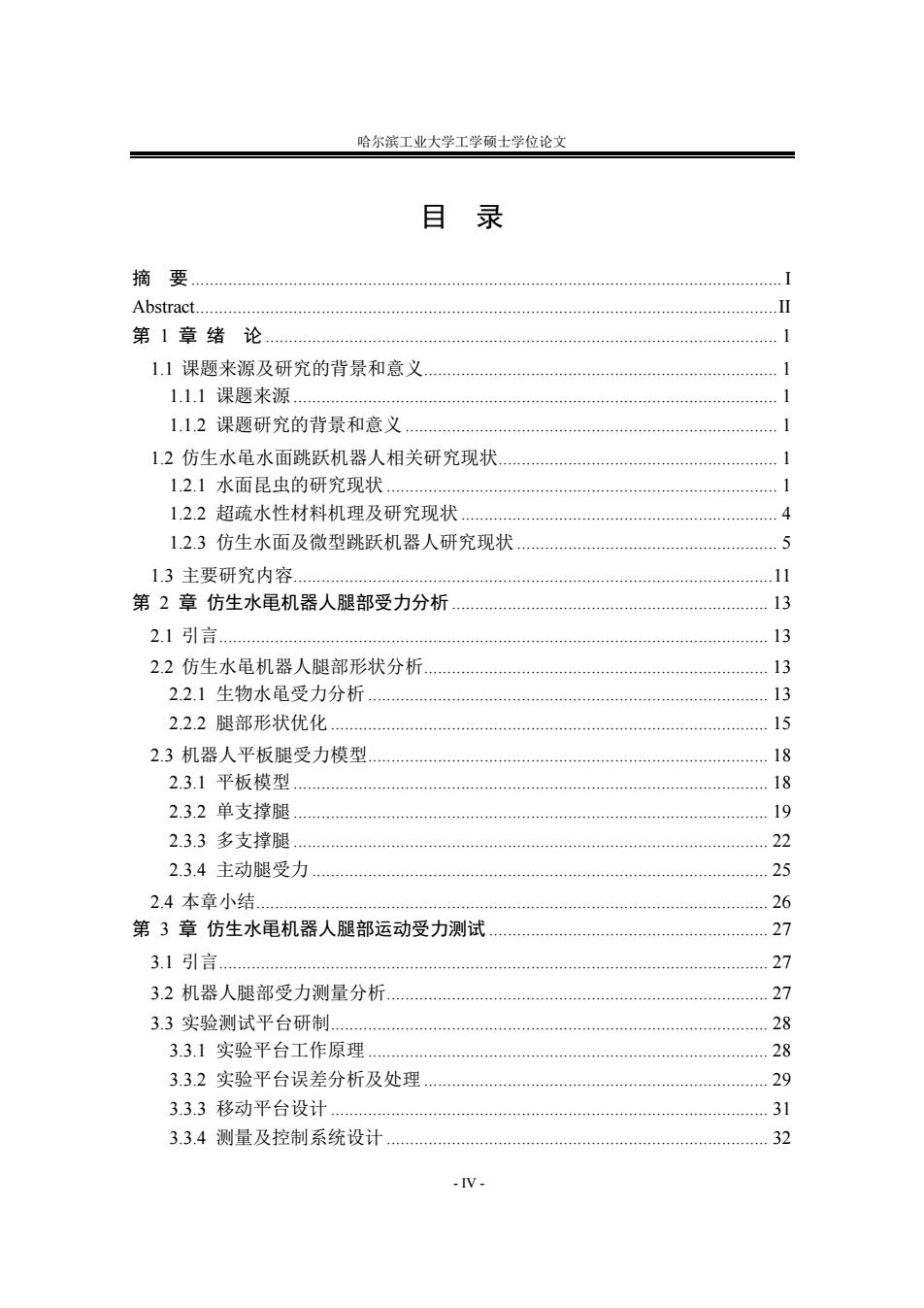
哈尔滨工业大学工学硕士学位论文 目 录 摘要 Abstract. 第1章绪论 1 11课题来源及研究的背景和意义 .1 1.1.1课题来源 .1 1.1.2课题研究的背景和意义 1 1.2仿生水黾水面跳跃机器人相关研究现状 1 1.2.1水面昆虫的研究现状 1.2.2超疏水性材料机理及研究现状 1.2.3仿生水面及微型跳跃机器人研究现状 5 1.3主要研究内容 11 第2章仿生水黾机器人腿部受力分析 13 2.1引言. 13 2.2仿生水黾机器人腿部形状分析 13 2.2.1生物水黾受力分析 13 2.2.2腿部形状优化 15 2.3机器人平板腿受力模型 18 2.3.1平板模型 18 2.3.2单支撑腿 19 2.3.3多支撑腿 22 2.3.4主动腿受力 25 24本章小结 26 第3章仿生水黾机器人腿部运动受力测试 27 3.1引言… 27 3.2机器人腿部受力测量分析. 27 3.3实验测试平台研制 28 3.3.1实验平台工作原理 28 3.3.2实验平台误差分析及处理 29 3.3.3移动平台设计 31 3.3.4测量及控制系统设计 32 -IV-
哈尔滨工业大学工学硕士学位论文 - IV - 目 录 摘 要...............................................................................................................................I Abstract.............................................................................................................................II 第 1 章 绪 论.............................................................................................................. 1 1.1 课题来源及研究的背景和意义............................................................................ 1 1.1.1 课题来源........................................................................................................ 1 1.1.2 课题研究的背景和意义................................................................................ 1 1.2 仿生水黾水面跳跃机器人相关研究现状............................................................ 1 1.2.1 水面昆虫的研究现状.................................................................................... 1 1.2.2 超疏水性材料机理及研究现状.................................................................... 4 1.2.3 仿生水面及微型跳跃机器人研究现状........................................................ 5 1.3 主要研究内容.......................................................................................................11 第 2 章 仿生水黾机器人腿部受力分析.................................................................... 13 2.1 引言...................................................................................................................... 13 2.2 仿生水黾机器人腿部形状分析.......................................................................... 13 2.2.1 生物水黾受力分析...................................................................................... 13 2.2.2 腿部形状优化.............................................................................................. 15 2.3 机器人平板腿受力模型...................................................................................... 18 2.3.1 平板模型...................................................................................................... 18 2.3.2 单支撑腿...................................................................................................... 19 2.3.3 多支撑腿...................................................................................................... 22 2.3.4 主动腿受力.................................................................................................. 25 2.4 本章小结.............................................................................................................. 26 第 3 章 仿生水黾机器人腿部运动受力测试............................................................ 27 3.1 引言...................................................................................................................... 27 3.2 机器人腿部受力测量分析.................................................................................. 27 3.3 实验测试平台研制.............................................................................................. 28 3.3.1 实验平台工作原理...................................................................................... 28 3.3.2 实验平台误差分析及处理.......................................................................... 29 3.3.3 移动平台设计.............................................................................................. 31 3.3.4 测量及控制系统设计.................................................................................. 32
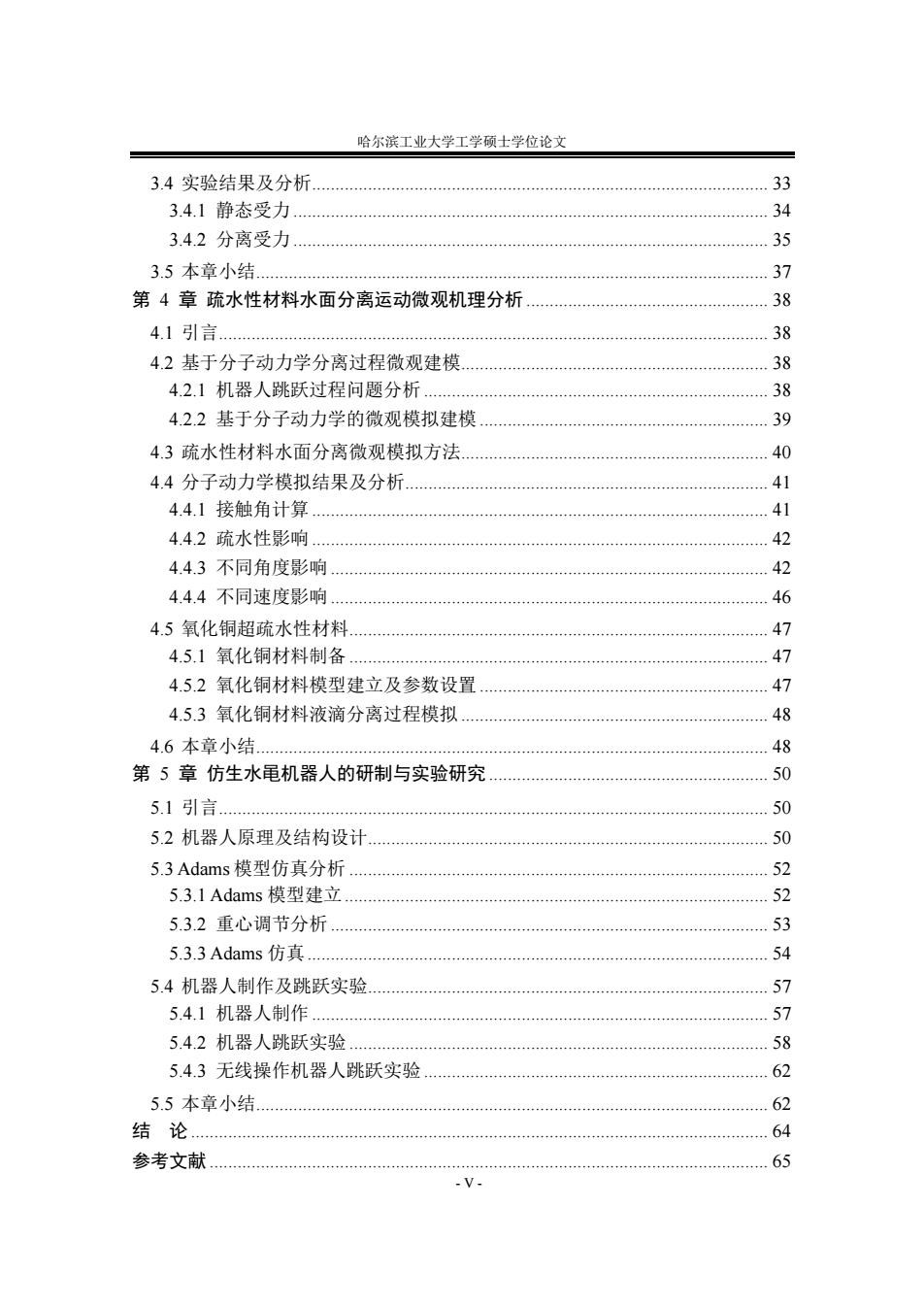
哈尔滨工业大学工学硕士学位论文 34实验结果及分析 33 3.4.1静态受力 34 3.4.2分离受力 35 3.5本章小结 37 第4章疏水性材料水面分离运动微观机理分析 38 4.1引言 38 4.2基于分子动力学分离过程微观建模 38 4.2.1机器人跳跃过程问题分析 38 4.2.2基于分子动力学的微观模拟建模 39 4.3疏水性材料水面分离微观模拟方法 40 4.4分子动力学模拟结果及分析 41 4.4.1接触角计算 41 4.4.2疏水性影响… 42 4.4.3不同角度影响 42 4.4.4不同速度影响 46 4.5氧化铜超疏水性材料. 47 4.5.1氧化铜材料制备 47 4.5.2氧化铜材料模型建立及参数设置 47 4.5.3氧化铜材料液滴分离过程模拟 48 4.6本章小结 48 第5章仿生水黾机器人的研制与实验研究 50 5.1引言 50 5.2机器人原理及结构设计 50 5.3 Adams模型仿真分析 52 5.3.1 Adams模型建立 52 5.3.2重心调节分析 53 5.3.3 Adams仿真… 54 5.4机器人制作及跳跃实验 57 5.4.1机器人制作 57 5.4.2机器人跳跃实验 58 5.4.3无线操作机器人跳跃实验 62 5.5本章小结 62 结论 64 参考文献 65
哈尔滨工业大学工学硕士学位论文 - V - 3.4 实验结果及分析.................................................................................................. 33 3.4.1 静态受力...................................................................................................... 34 3.4.2 分离受力...................................................................................................... 35 3.5 本章小结.............................................................................................................. 37 第 4 章 疏水性材料水面分离运动微观机理分析.................................................... 38 4.1 引言...................................................................................................................... 38 4.2 基于分子动力学分离过程微观建模.................................................................. 38 4.2.1 机器人跳跃过程问题分析.......................................................................... 38 4.2.2 基于分子动力学的微观模拟建模.............................................................. 39 4.3 疏水性材料水面分离微观模拟方法.................................................................. 40 4.4 分子动力学模拟结果及分析.............................................................................. 41 4.4.1 接触角计算.................................................................................................. 41 4.4.2 疏水性影响.................................................................................................. 42 4.4.3 不同角度影响.............................................................................................. 42 4.4.4 不同速度影响.............................................................................................. 46 4.5 氧化铜超疏水性材料.......................................................................................... 47 4.5.1 氧化铜材料制备.......................................................................................... 47 4.5.2 氧化铜材料模型建立及参数设置.............................................................. 47 4.5.3 氧化铜材料液滴分离过程模拟.................................................................. 48 4.6 本章小结.............................................................................................................. 48 第 5 章 仿生水黾机器人的研制与实验研究............................................................ 50 5.1 引言...................................................................................................................... 50 5.2 机器人原理及结构设计...................................................................................... 50 5.3 Adams 模型仿真分析 .......................................................................................... 52 5.3.1 Adams 模型建立........................................................................................... 52 5.3.2 重心调节分析.............................................................................................. 53 5.3.3 Adams 仿真................................................................................................... 54 5.4 机器人制作及跳跃实验...................................................................................... 57 5.4.1 机器人制作.................................................................................................. 57 5.4.2 机器人跳跃实验.......................................................................................... 58 5.4.3 无线操作机器人跳跃实验.......................................................................... 62 5.5 本章小结.............................................................................................................. 62 结 论............................................................................................................................ 64 参考文献........................................................................................................................ 65

哈尔滨工业大学工学硕士学位论文 攻读硕士学位期间发表的论文及其它成果 68 附录 69 哈尔滨工业大学学位论文原创性声明和使用权限 70 致谢.… 71 VI-
哈尔滨工业大学工学硕士学位论文 - VI - 攻读硕士学位期间发表的论文及其它成果................................................................ 68 附 录............................................................................................................................ 69 哈尔滨工业大学学位论文原创性声明和使用权限.................................................... 70 致 谢............................................................................................................................ 71
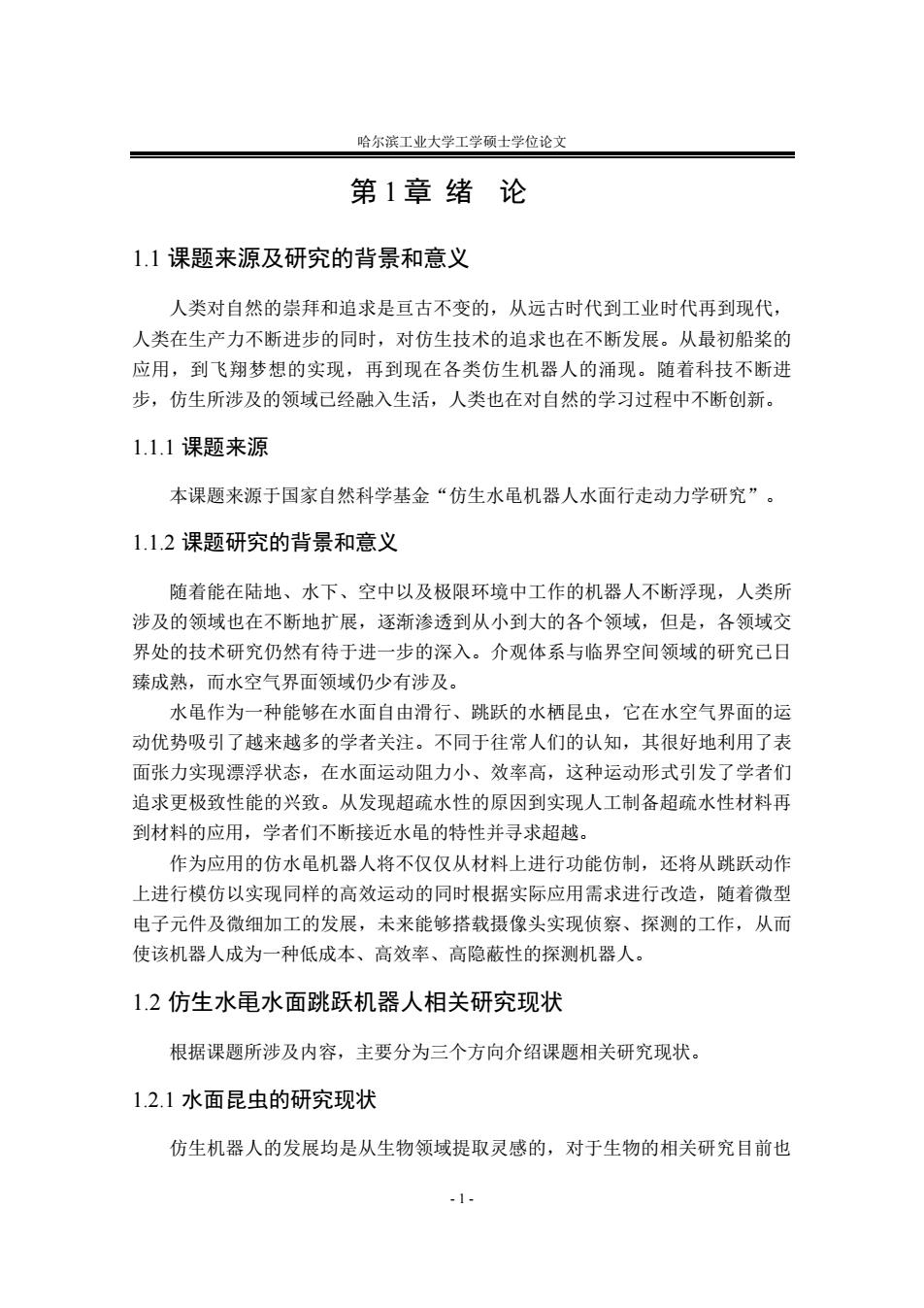
哈尔滨工业大学工学硕士学位论文 第1章绪论 1.1课题来源及研究的背景和意义 人类对自然的崇拜和追求是亘古不变的,从远古时代到工业时代再到现代, 人类在生产力不断进步的同时,对仿生技术的追求也在不断发展。从最初船桨的 应用,到飞翔梦想的实现,再到现在各类仿生机器人的涌现。随着科技不断进 步,仿生所涉及的领域已经融入生活,人类也在对自然的学习过程中不断创新。 1.1.1课题来源 本课题来源于国家自然科学基金“仿生水黾机器人水面行走动力学研究”。 1.1.2课题研究的背景和意义 随着能在陆地、水下、空中以及极限环境中工作的机器人不断浮现,人类所 涉及的领域也在不断地扩展,逐渐渗透到从小到大的各个领域,但是,各领域交 界处的技术研究仍然有待于进一步的深入。介观体系与临界空间领域的研究已日 臻成熟,而水空气界面领域仍少有涉及。 水黾作为一种能够在水面自由滑行、跳跃的水栖昆虫,它在水空气界面的运 动优势吸引了越来越多的学者关注。不同于往常人们的认知,其很好地利用了表 面张力实现漂浮状态,在水面运动阻力小、效率高,这种运动形式引发了学者们 追求更极致性能的兴致。从发现超疏水性的原因到实现人工制备超疏水性材料再 到材料的应用,学者们不断接近水黾的特性并寻求超越。 作为应用的仿水黾机器人将不仅仅从材料上进行功能仿制,还将从跳跃动作 上进行模仿以实现同样的高效运动的同时根据实际应用需求进行改造,随着微型 电子元件及微细加工的发展,未来能够搭载摄像头实现侦察、探测的工作,从而 使该机器人成为一种低成本、高效率、高隐蔽性的探测机器人。 1.2仿生水黾水面跳跃机器人相关研究现状 根据课题所涉及内容,主要分为三个方向介绍课题相关研究现状。 1.2.1水面昆虫的研究现状 仿生机器人的发展均是从生物领域提取灵感的,对于生物的相关研究目前也 -1-
哈尔滨工业大学工学硕士学位论文 - 1 - 第 1 章 绪 论 1.1 课题来源及研究的背景和意义 人类对自然的崇拜和追求是亘古不变的,从远古时代到工业时代再到现代, 人类在生产力不断进步的同时,对仿生技术的追求也在不断发展。从最初船桨的 应用,到飞翔梦想的实现,再到现在各类仿生机器人的涌现。随着科技不断进 步,仿生所涉及的领域已经融入生活,人类也在对自然的学习过程中不断创新。 1.1.1 课题来源 本课题来源于国家自然科学基金“仿生水黾机器人水面行走动力学研究”。 1.1.2 课题研究的背景和意义 随着能在陆地、水下、空中以及极限环境中工作的机器人不断浮现,人类所 涉及的领域也在不断地扩展,逐渐渗透到从小到大的各个领域,但是,各领域交 界处的技术研究仍然有待于进一步的深入。介观体系与临界空间领域的研究已日 臻成熟,而水空气界面领域仍少有涉及。 水黾作为一种能够在水面自由滑行、跳跃的水栖昆虫,它在水空气界面的运 动优势吸引了越来越多的学者关注。不同于往常人们的认知,其很好地利用了表 面张力实现漂浮状态,在水面运动阻力小、效率高,这种运动形式引发了学者们 追求更极致性能的兴致。从发现超疏水性的原因到实现人工制备超疏水性材料再 到材料的应用,学者们不断接近水黾的特性并寻求超越。 作为应用的仿水黾机器人将不仅仅从材料上进行功能仿制,还将从跳跃动作 上进行模仿以实现同样的高效运动的同时根据实际应用需求进行改造,随着微型 电子元件及微细加工的发展,未来能够搭载摄像头实现侦察、探测的工作,从而 使该机器人成为一种低成本、高效率、高隐蔽性的探测机器人。 1.2 仿生水黾水面跳跃机器人相关研究现状 根据课题所涉及内容,主要分为三个方向介绍课题相关研究现状。 1.2.1 水面昆虫的研究现状 仿生机器人的发展均是从生物领域提取灵感的,对于生物的相关研究目前也